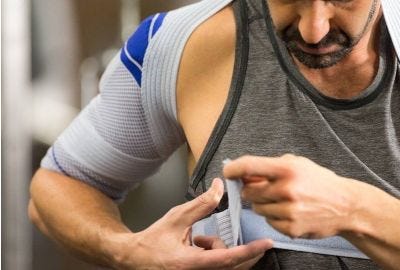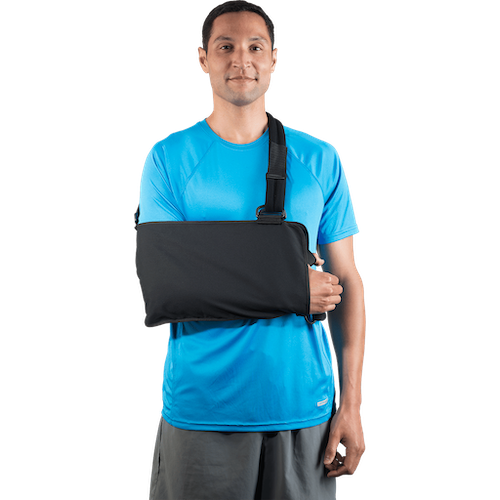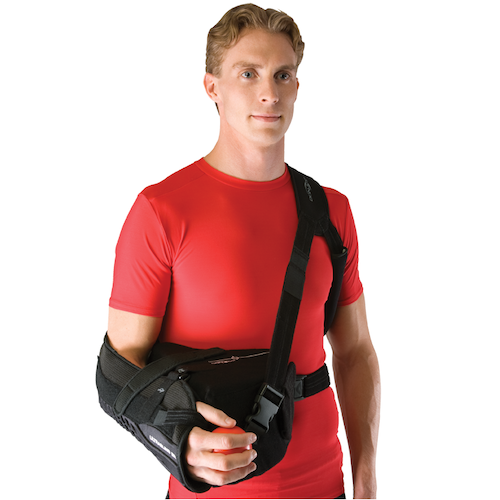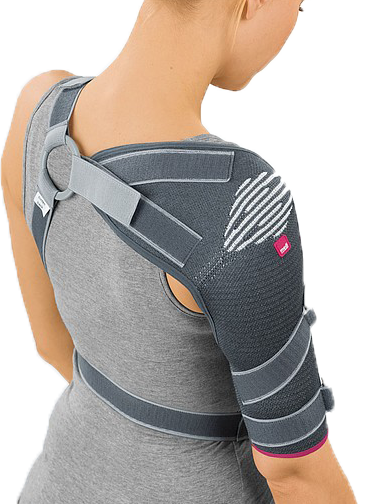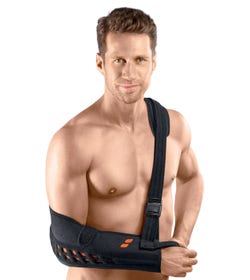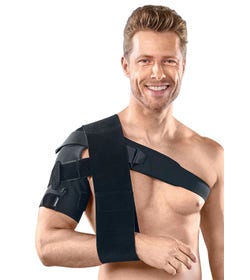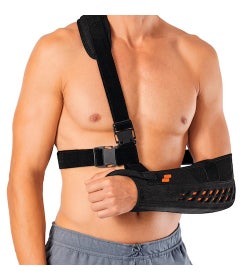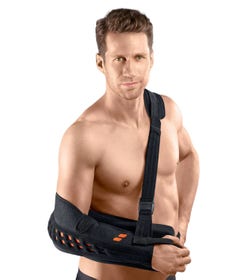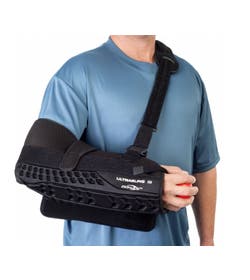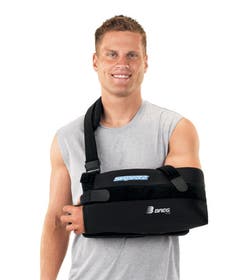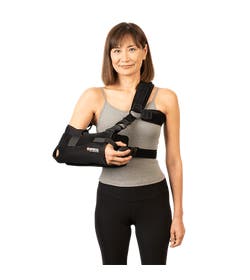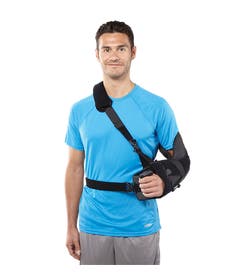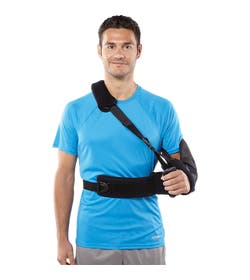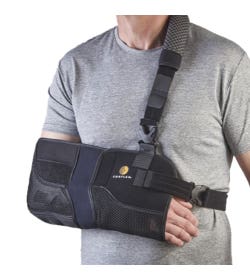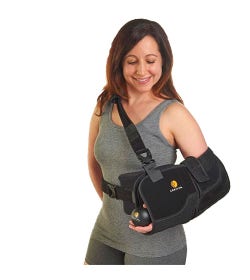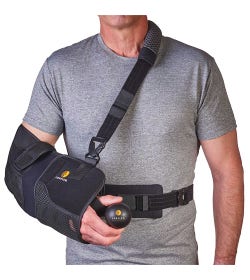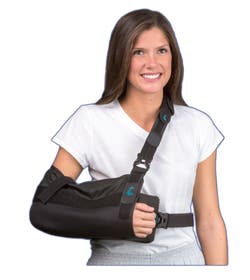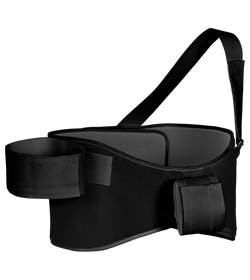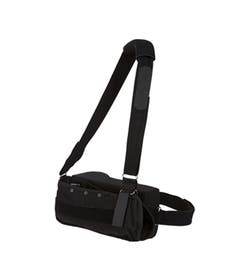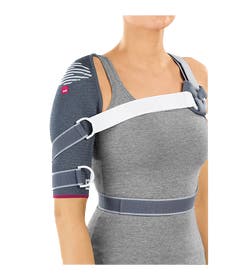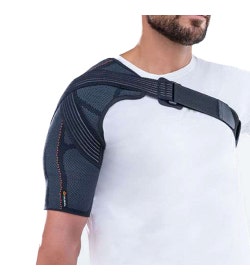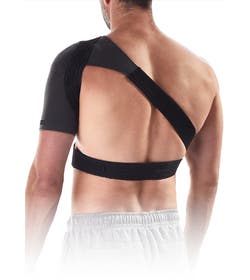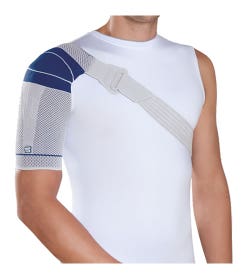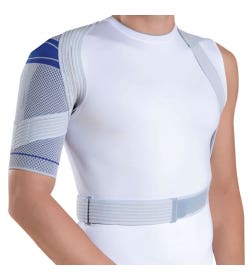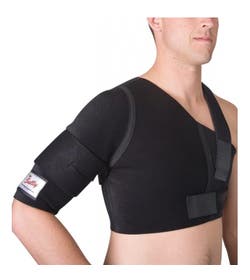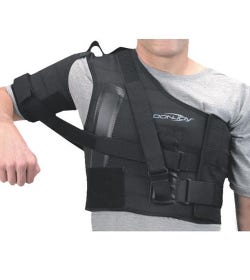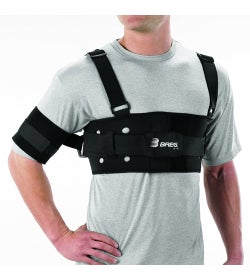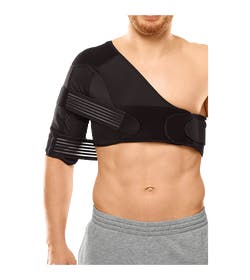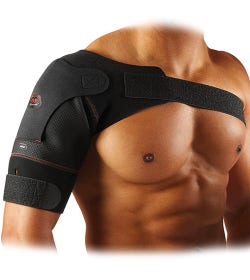If you have a shoulder injury (or you're recovering from surgery) a doctor or physical therapist may recommend a shoulder sling, immobilizer, or stabilizer to aid in the healing process.
In this blog post, we will discuss the differences between shoulder slings, immobilizers, and stabilizers, as well as the common injuries and conditions they are used to treat.
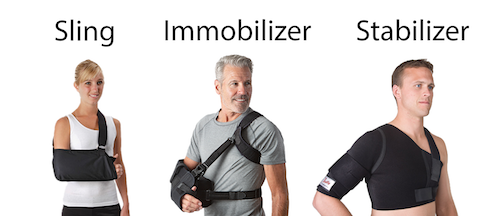

Shoulder Slings, Immobilizers, Stabilizers - What's the Difference?
1) Shoulder Slings and Immobilizers
Basic slings use a strap around the neck to help support the weight of the arm. A basic arm sling will have one shoulder strap which is usually adjustable in length. The shoulder strap typically has some padding to make it comfortable for wear for extended periods. Arm slings feature a pouch (or envelope) of material that the arm rests in.
Immobilizers are more advanced versions of a shoulder sling. They are typically used for more serious injuries or after procedures like rotator cuff surgery and are designed to completely restrict movement of the shoulder joint.
They differ from a basic sling because they can be used to orient your shoulder in different fixed positions, such as: external rotation, internal rotation, or abduction (as advised by your healthcare provider). An immobilizer usually has a chest band, an arm band, and a wrist band. They also have a strap that is attached to the arm sling and fastened around the waist. Immobilizers also have pillows that can be added or removed to support the different arm orientations.
2) Shoulder Stabilizer
A shoulder stabilizer is a support (more like a garment) that you wear around your shoulder and upper torso (chest and arm) for everyday use. It is usually made of a compressive fabric, along with some straps that may attach to the chest and/or opposite shoulder.
They are designed to provide extra support to the shoulder joint during physical activity or protect against harmful movements, while not fully immobilizing your shoulder.
Stabilizers are commonly used by athletes or individuals with chronic shoulder issues (such as recurring shoulder dislocations). They are not designed to fully immobilize the shoulder as you want to encourage strength and movement of the shoulder joint to prevent conditions from developing: like frozen shoulder (adhesive capsulitis).
Basic sling: is a piece of fabric/strap that wraps around the neck (and sometimes your waist) and cradles your arm and supports the shoulder by keeping the arm/forearm resting near your body. The shoulder rests in an inwards (internal rotation) position.
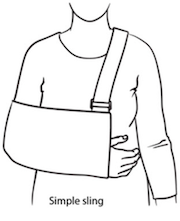

Abduction sling: is a sling that is connected through velcro straps (or clips) to a pillow that sits on the side of your body. Your arm rests over the pillow, keeping the forearm away (and shoulder slightly lifted) from the body. This arm / shoulder orientation is called “abduction”. The degree of abduction and orientation of the arm is influenced by the shape and size of pillow used.
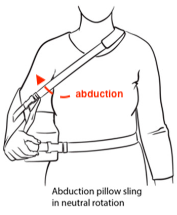

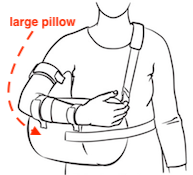

Shoulder Slings / Immobilizers - What Type Do You Need?
External rotation brace: certain procedures benefit from holding your forearm outwards in an externally rotated position. This can be achieved with the use of a shoulder immobilizer similar to the abduction sling, but with a triangular wedge pillow. This rotates your forearm so that your wrist is farther away from your body than your elbow is.
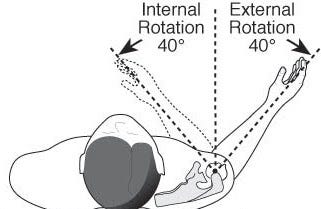

Slings come in a few main varieties: a basic shoulder sling, an immobilizer with a small or large pillow (shoulder abduction sling), and an immobilizer with a wedge shaped pillow (external rotation). We've summarized the types of conditions that are typically used for each sling style (so that you can get a general idea for what they are used for), but it is always best to consult your healthcare professional to determine what type is appropriate for your specific condition.
Browse Shoulder Slings and Immobilizers
Shoulder Stabilizers - When Should They Be Used?
Shoulder stabilizers come in a few different configurations. Most include a portion that slides over (or wraps around) the upper arm and shoulder area, up to your clavicle (collar bone). Some of the lighter support devices include a cross body or torso strap to provide some leverage. The more robust supports have a component of the support that covers the chest/torso and then attaches to the shoulder portion (with multiple straps for maximum strength). The range of motion control can be configured for anterior, multi–directional, inferior, and posterior instabilities.
Browse Shoulder Stabilizers
Tips - How To Get The Most From Your Shoulder Sling, Immobilizer, Stabilizer
Sizing
Slings, immobilizers and stabilizers are manufactured in multiple sizes, so it's important to follow the size recommendations from the manufacturer. In the case of slings, using the incorrect size can lead to you holding the weight of your arm (instead of the brace doing the work), which leads to pain around the shoulder and shoulder blade (in addition to not providing the full protection needed for the shoulder). With immobilizers, an incorrect size could result in the range of motion control being less optimal, which could result in injury.
Proper Fit
When selecting a shoulder sling, immobilizer or stabilizer, it is important to choose one that matches your diagnosis, and fits comfortably.
To properly fit a shoulder sling, place the injured arm in the sling with the elbow bent at a 90-degree angle. The wrist should be supported by the sling, and the arm should be secured to the body to prevent swinging or movement. The neck strap should be adjusted so that the sling is snug but not tight. Look for a sling that is adjustable so that it can be customized to your specific needs. The sling should also be made of breathable material to prevent sweating and irritation.
When selecting a shoulder stabilizer, look for one that is adjustable to allow for customization to your body shape. To properly fit a shoulder support, place the injured arm in the support and adjust the straps so that it fits snugly but does not restrict blood flow or cause discomfort. The support should be worn during physical activity to provide extra support to the shoulder joint.
Set-up and Proper Use
Shoulder slings, immobilizers and stabilizers are designed to be adjustable to acommodate ranges of motion control, diagnosis and types of shoulder movements. You should discuss the correct set-up (such as the sequence and orientation of the straps or pillow) with your healthcare professional before wearing one. This will ensure that you wear the device in the correct way to have optimal support during the specific movements where you are most susceptible to injury (based on your condition).
Showering
If you're using a shoulder sling after surgery, you should talk to your surgeon first to make sure you understand their preferences for your recovery. If you are allowed to shower a shoulder immobilizer is not ideal to get wet as they are made of materials and fabric that do not dry easily. One option is to use a very simple shoulder sling for showers or depending on your doctors recommendation it may be safe to take a shower without a sling, just letting the arm rest by your side.
Day / night use
It is typically recommended to use your sling or immobilizer for most of the day and night but you would take off the immobilizer to get dressed, shower, and perform physical therapy. During activity or when going to sleep, the shoulder immobilizer provides protection and should be used.
It's important to note that these are just general tips. Always follow the rehabilitation protocols that you have been given by your doctor or physical therapist.

